Motorists across the north are being warned there is an increased risk of collisions with deer as the clocks go back.
This means that more commuters will be heading home as the sun goes down, the time deer move down to feed at the roadside.
Car accidents involving deer peak at this time of year, and because of this, Scottish Natural Heritage (SNH), in conjunction with Transport Scotland and Traffic Scotland, are placing warning messages on a number of north trunk roads most commonly affected by deer accidents.
Warnings will be shown from Sunday on the A9 Inverness-Perth, the A87 Invergarry-Kyle, the A82 Inverness-Glasgow, A85 Oban-Perth and the A835 Ullapool-Tore.
The most recent deer-vehicle collisions research shows there are more than 7,000 collisions between motor vehicles and deer every year in Scotland, with an average of 65 of these resulting in human injuries.
Up to 70% of these occur on trunk roads or motorways
Sinclair Coghill, SNH deer management officer, said: “From October to December, there is a higher risk of deer on the road as deer move down to lower lying ground for forage and shelter, with the highest risk from sunset to midnight and shortly before and after sunrise.
“We advise motorists to slow down and watch for deer crossing roads.
“Be particularly alert if you’re driving near woods where deer can suddenly appear before you have time to brake.
“If you do hit a deer, report it to the police, as the deer may be fatally injured and suffering.”
Many people think most incidents with deer occur on more remote Highland roads, but in fact up to 70% occur on trunk roads or motorways.
Tips for avoiding accidents with deer offered by SNH include using full-beams when there is no oncoming traffic in order to spot deer on or near the roadway.
Other tips include not swerving to avoid hitting a deer. as a collision with oncoming traffic could be worse.
Only break sharply and stop if there is no danger of being hit by following or oncoming traffic.
Be aware that more deer may cross after the one or two you first see, as deer often travel in groups.
After dark, use full-beams when there is no oncoming traffic, as this will illuminate the eyes of deer on or near a roadway and give you more time to react. But dim your headlights when you see a deer or other animal on the road so you don’t startle it.
Do not approach an injured deer yourself it may be dangerous.
